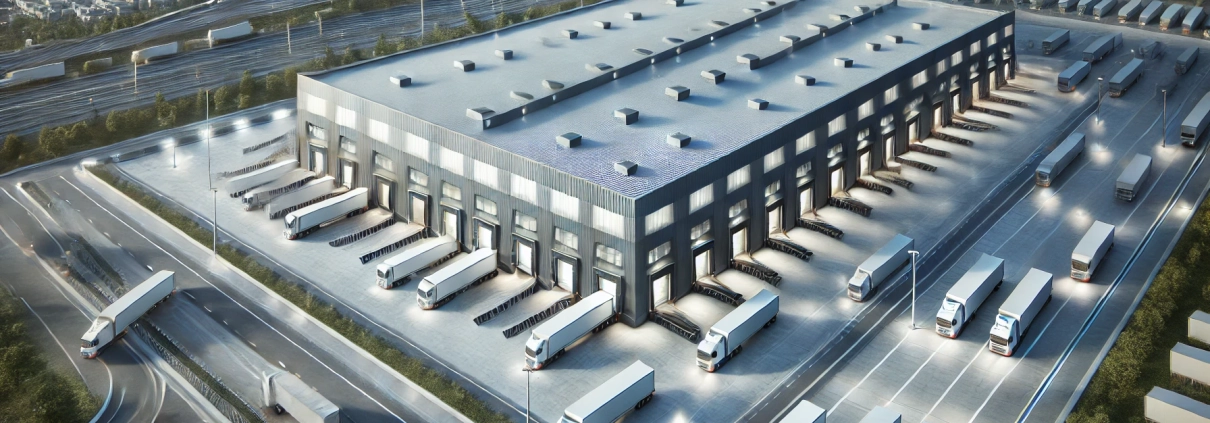Cross-docked
In an industrial cross-docked building, dock doors are located on opposite sides of the building (typically the front and rear), which allows for the unloading of goods from inbound delivery trucks and loading the same goods directly onto outbound trucks. Typically, there is little to no storage between the dock doors to inhibit the process.
Putting ‘Cross-docked’ in Context
Lone Star Industrial Partners, a real estate private equity firm focused on core investments, is acquiring Northpoint Logistics Center, a 150,000-square-foot cross-docked industrial facility located in the thriving Dallas-Fort Worth (DFW) metroplex. The DFW area is a key logistics hub, known for its excellent transportation infrastructure and access to major interstate highways, making it an ideal location for distribution and fulfillment centers.
Property Details
Northpoint Logistics Center is a modern, cross-docked building with dock doors strategically placed on both the front and rear sides of the structure. This design allows for seamless logistics operations by enabling goods to be efficiently unloaded from inbound delivery trucks and immediately reloaded onto outbound trucks with minimal handling time. The building’s layout is intentionally designed with little to no storage space between the dock doors, which minimizes the time goods spend in the facility and maximizes the efficiency of the supply chain.
Practical Application of Cross-docking
In this scenario, the cross-docked configuration of Northpoint Logistics Center plays a critical role in its appeal to tenants and investors alike. One of the major tenants is a leading e-commerce company that relies heavily on fast turnaround times to meet its delivery promises to customers. The cross-docking setup allows this tenant to receive products from suppliers on one side of the building, immediately sort them based on outbound destinations, and then quickly load them onto trucks on the opposite side for distribution to local markets or regional warehouses.
This efficient flow of goods reduces the need for long-term storage, lowers operating costs, and speeds up delivery times—key metrics for success in the highly competitive logistics and e-commerce sectors. Additionally, the property’s strategic location in the DFW area, coupled with its cross-docked design, ensures high demand from tenants who prioritize speed and efficiency in their supply chains.
Financial and Operational Considerations
From an investment perspective, Northpoint Logistics Center is expected to generate stable, long-term cash flows due to its fully leased status and the quality of its tenant base. The cross-docked design not only enhances operational efficiency for tenants but also contributes to the property’s long-term value by appealing to a wide range of potential tenants in the logistics and distribution sectors.
Lone Star Industrial Partners sees this acquisition as a low-risk, core investment that will provide consistent returns over time, supported by the building’s modern amenities, strategic location, and functional design tailored to the needs of high-demand industrial users.
Frequently Asked Questions about Cross-docked Industrial Buildings
What does “cross-docked” mean in industrial real estate?
In a cross-docked building, dock doors are placed on opposite sides of the facility, allowing goods to be unloaded from inbound trucks and directly loaded onto outbound trucks with minimal to no storage in between.
What is the primary benefit of a cross-docked layout?
The main benefit is increased operational efficiency—goods can move quickly through the facility, minimizing handling and storage time, which lowers costs and speeds up delivery.
Why is little or no storage space used in cross-docking?
Minimal storage is used to avoid delays in moving goods through the supply chain. The design is meant to facilitate rapid transfer between inbound and outbound transportation.
How is cross-docking used by tenants like e-commerce companies?
E-commerce tenants use cross-docking to receive, sort, and quickly ship products to regional warehouses or customers, supporting fast delivery and minimizing storage costs.
Why is the Dallas-Fort Worth area ideal for cross-docked facilities?
DFW offers excellent transportation infrastructure and access to major highways, making it a prime location for logistics operations and supporting quick regional distribution.
What makes Northpoint Logistics Center attractive to investors?
Its cross-docked design enhances tenant efficiency, it is fully leased to strong tenants, and it’s located in a key logistics hub, offering stable, long-term income potential.
How does cross-docking affect the value of industrial properties?
Cross-docking increases property value by appealing to a wide range of logistics and distribution tenants that prioritize fast, efficient operations.
What type of tenants typically occupy cross-docked facilities?
Tenants include e-commerce companies, logistics firms, and other distribution-focused businesses that require rapid processing and minimal storage.
Click here to get this CRE Glossary in an eBook (PDF) format.

